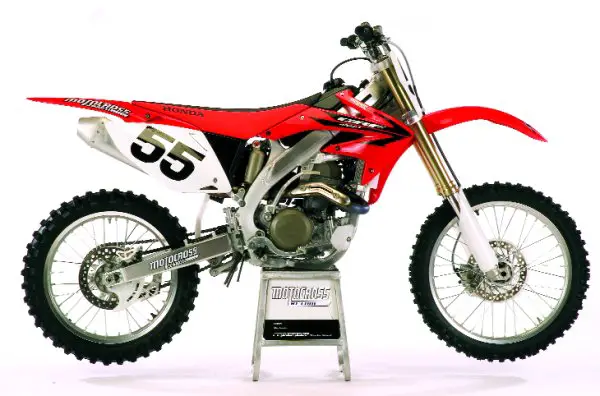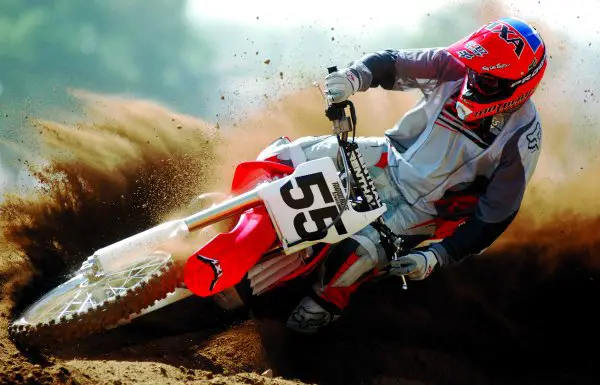2006 HONDA CRF450 TEST
In our opinion, Honda took a quantum leap forward with the CRF450 in 2005. One year ago, Honda changed the frame geometry with a fourth generation twin-spar frame. They improved the shift drum, shift forks and shift fork shafts for more accurate shifting. They updated the plastic to CRF250-style components. They redesigned the rear hub, clutch cable bracket, brake pedal, and seat bolts. They narrowed the radiators. They changed the steering axis by pulling the front axle back 2mm. Good stuff.

We loved last year’s changes. And, with a pregnant pause, we have to wonder if the 2006 changes will make as big a dent in our psyches.
Q: WHAT DID HONDA CHANGE ON THE 2006 CRF450?
A: If you were expecting a wholesale revision, you will be disappointed. The 2006 mod list is short and sweet.
Fork tubes: Honda shortened the fork legs by 7mm. Why? Because no one ever used the optional 20-inch front wheel, and that is why Honda added the 7mm in the first place. Most of the time that 7mm was sticking up above the triple clamps.
Valve seats: The intake valves got the same valve seats that the CRF450X used last year. Why? The previous valve seats got cupped; the new ones are more durable.
Crankshaft: Honda lowered the crankshaft 5mm by tilting the engine forward in the frame (requiring a new lower frame cradle and front motor mounts). Even though they tilted the engine forward and down, the countershaft sprocket stayed in the same location. To achieve this magic act, Honda had to bore the center cases with an offset hole. Why didn’t they just let the swingarm pivot move down with the tilted engine? Because it would alter the chain torque on the rear suspension. And that was a can of worms Honda didn’t want to open.
Subframe: When the engine moved forward, so did the carburetor. The quick fix would have been to lengthen the air boot to bridge the gap to the Keihin’s velocity stack, but Honda’s engineers didn’t want to make any changes to the 2005 airbox. As a result, they redesigned the subframe to move the old airbox 7.5mm forward.
Mid-pipe mount: The mid-pipe mount of the exhaust pipe is mounted on the subframe instead of the frame. Honda reported some breakages on the old mount, but we never saw any.
Muffler: The muffler moved forward with the subframe, and its bracket is relocated.
Front hub: The new front hub is lighter and stronger.
Radiators: Honda lowered the radiators on the frame by 5mm. Why? To lower the water weight.
Q: OF ALL THE CHANGES HONDA MADE, WHICH IS THE MOST SIGNIFICANT?
A: Lowering the crankshaft is the most noticeable change on the 2006 CRF450. By moving the crank 5mm lower in the chassis, the center of gravity is moved down, which lessens chassis roll rate by 2.7 percent. What does that mean? It means that the 2006 CRF450 feels less floppy at turn-in and from center-out in the corners. What is a 2.7 percent reduction? We wish we knew the mathematical formula, but suffice it to say that the lower the mass (or more accurately, the closer the mass to the center of gravity), the easier it is to initiate direction changes with roll (which is techno-talk for lean angles).
Q: DO YOU NEED A SAILBOAT ANALOGY?
A: Who doesn’t? A sailboat gets its roll stability from its dagger board, skeg or keel. America’s Cup sailboats have high-tech keels that carry a tremendous amount of weight below the surface of the water. This very low center of gravity allows them to lean radically with the wind without capsizing.
On a motocross bike, the height of the crankshaft and axles is the same as the surface of the water to a sailboat. The more weight (and, in the case of the crankshaft, rotating mass) that can be positioned below the center of gravity, the easier it is to achieve and maintain steep lean angles.
Thus, by lowering the crank, Honda has borrowed the keel from an America’s Cup sailboat.
Q: WHAT DID THEY CHANGE ON THE CRF450 ENGINE?
A: The quick and easy answer is nothing. It is the same. Honda made no changes to the engine (other than the valve seats).

Q: HOW GOOD IS THE 2006 CRF450 POWERBAND?
A: Honda has built the perfect blend of usability and horsepower. Even though the engine is unchanged for 2006, Honda did swap out last year’s QQ needle for a newer needle that seems to pump up the low-to-mid transition.
On the dyno, the 2005 and 2006 are identical twins.
Q: WHAT ABOUT THE GEARING?
A: We raced it stock. Kudos to the powerbandit gets the job done.
Q: DO WE HAVE ANY SQUAWKS WITH THE 2006 CRF450?
A: Nothing new. Here are MXA’s personal squawks.
Rear brake overheating: Last year, Honda’s engineers borrowed a page from the garage mechanics and upgraded the rear brake pad insulators to lessen brake fade. It worked for the majority of people, but brake draggers can still get squeal.
Air box congestion: We know that Honda’s engineers were adamant that the 2005 CRF airbox not be changed on the 2006 model, but we can’t agree. We would have added the extra 7.5mm to the back of the airbox to aid in getting the filter out. It’s tight in there.
Hot start trigger: We wish Honda would stop mounting the hot start trigger on top of the clutch perch. Every time we flip the CRF, we break off the hot start cable holder. When this happens, we have to buy a DR.D Hot Start thumb lever.
Tire choice: We loved the Dunlop D756 rear tire, but don’t think that the 742 front has a wide enough range to be an OEM tire. We’d prefer a 739 or a 756 front.
Q: WHAT ABOUT THAT SHOWA SUSPENSION?
A: It’s firmer on compression, which makes it better overall. It stays a little higher in the stroke, and fits a wider variety of riders.
That said, MXA test riders have a tried-and-true fix for Showa forks that has worked since 2002. We install stiffer 0.49 kg/mm fork springs and lower the oil height from 385cc to 375cc. We set the compression and rebound on ten clicks out. With the stiffer fork springs and lower oil height, the fork is plusher over small bumps, stays higher in its stroke on consecutive hits and can handle the big landings. Do it.
The shock is decent. We set the sag at 100mm, low-speed compression on 12, high-speed at two turns out and rebound on ten. It was a little kicky over braking bumps (which required a delicate touch with the rebound adjuster).
Q: DOES THE 2006 CRF450 MAKE THE 2005 MODEL OBSOLETE?
A: What most consumers want to know is whether they should sell their old CRF450 and buy a 2006 model. If you own a 2002, 2003 or 2004 CRF450, you haven’t even come close to experiencing the joy of Honda ownership. Bikes from the first three years of CRF development had handling flaws that can’t be fixed with band-aids. Of added concern is the life cycle of a three-year-old four-stroke engine. Not that it will blow up tomorrow, but it is three years closer to devastation than a new engine.
Owners of a 2005 CRF450 have a tougher decision to make. The important stats (frame geometry, dyno numbers and dimensions) are unchanged. The true-to-life difference between an ?05 and ?06 CRF450 can best be felt at turn-in. It’s so subtle that most people wouldn’t recognize it (or their setup would negate it). Yet, on the other hand, it is a handling plus that can’t be denied.
Q: COULD YOU RETROFIT A 2005 TO MIMIC 2006 HANDLING?
A: Yes and no. No matter how creative you are, you cannot lower the crankshaft on your 2005 CRF450 by 5mm. That is beyond garage technology. But, we think that it would be possible to achieve some of the same results with a backyard mass centralization program of your own. The MXA wrecking crew tested lowered radiator kits from PWC and Fluidyne that moved significant water weight as much as two inches down on the frame (albeit on a YZ450F and RM-Z450). In both cases, test riders could feel the difference.
A simple mod like this could produce positive results on an ’05 that would mimic the effects of the lowered crankshaft.
Q: WHAT DID WE HATE?
A: The hate list:
(1) Air box: There is no room to maneuver in there.
(2) Fork springs: The forks are re-valved, but faster riders will still need stiffer springs. No secretalmost everyone ran 0.49s on the National circuit this year.
(3) Front tire: While we love the Dunlop D756 rear tire, we wish Honda would switch the stock D742 for a D739 or D756. They work better in a wider range of dirt.
(4) Seat foam: Our foam was on the soft side when the bike was new. The 2006 seat has a new part number (because of the new subframe).
(5) Engine heat: Our 2006 model spewed out water on hot days. Honda surmised that we were a little lean, but on a hot day a bike typically runs rich.
(6) Spokes: Watch the spokes next to the rim locks.
Q: WHAT DID WE LIKE?
A: The like list:
(1) Engine: We are glad that Honda didn’t mess with success. This engine is all about throttle response, ease-of-use and broader power. It is the perfect blend.
(2) Handlebars: We have never complained about Renthal 971 aluminum bars. Good stuff.
(3) Ergonomics: The CRF450 is comfortable. The handlebars, levers, shifter, footpegs and rear brake are all in the right place.
Q: WHAT DO WE REALLY THINK?
A: Why mess with success?





Comments are closed.